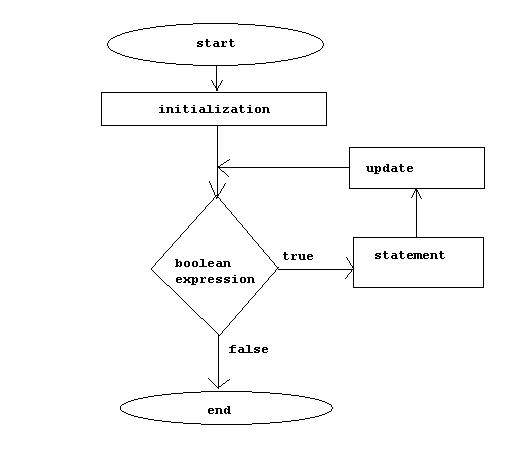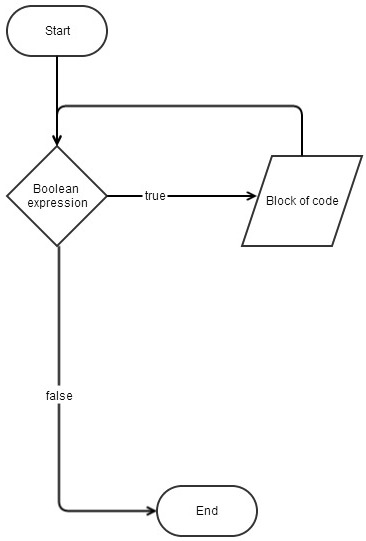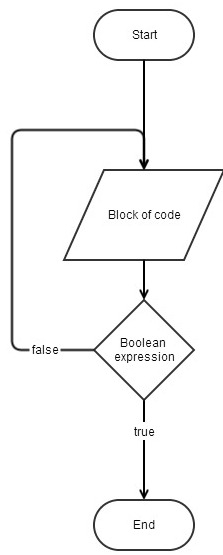Loops: Difference between revisions
>GoldenUrg →See Also: fixed link name |
>Camoy formatted |
||
| Line 1: | Line 1: | ||
==Loops== | |||
===What is a Loop?=== | |||
A loop is a chunk of code that is executed many times over. There are three types of loops, for, while, and repeat. Each one loops a block of code, but in different ways. You will see the differences between each of the loops later on. The reason why one would use a loop is that loops are great ways to not repeat the same code over and over. Let's dive in! | |||
===For=== | |||
The '''for''' loop is a way of running a command or set of commands a set number of times. | |||
The | |||
[[Image:Forflowchart.JPG]] | [[Image:Forflowchart.JPG]] | ||
| Line 21: | Line 12: | ||
For example, if you know you want to print "Hello Mom!" ten times, then you can use the <b>for</b> loop. | For example, if you know you want to print "Hello Mom!" ten times, then you can use the <b>for</b> loop. | ||
<pre> | {{Example|<pre> | ||
for i=1,10 do | for i=1,10 do | ||
print("Hello Mom!") | print("Hello Mom!") | ||
end | end | ||
</pre> | </pre>}} | ||
In the | In the '''for''' command, you see two numbers: 1, which is the starting value, and 10, which is the ending value. The loop will run from 1 to 10, and print "Hello Mom!" once per each number between 1 and 10 -- 10 times. | ||
Lua will assume you are going to be adding positive numbers. If you want to get fancy, such as subtracting numbers, or adding decimals, you have to specify this as follows: | Lua will assume you are going to be adding positive numbers. If you want to get fancy, such as subtracting numbers, or adding decimals, you have to specify this as follows: | ||
<pre> | {{Example|<pre> | ||
for i=10,1, -1 do | for i=10,1, -1 do | ||
print(i) | print(i) | ||
end | end | ||
</pre> | </pre>}} | ||
Notice that we have specified that we want to count downwards from 10 to 1, and we are subtracting 1 number every time. The output will be 10, 9, 8, 7, 6, 5, 4, 3, 2, 1. | Notice that we have specified that we want to count downwards from 10 to 1, and we are subtracting 1 number every time. The output will be 10, 9, 8, 7, 6, 5, 4, 3, 2, 1. | ||
| Line 41: | Line 32: | ||
Another example, but with decimals: | Another example, but with decimals: | ||
<pre> | {{Example|<pre> | ||
for i=1,10, .5 do | for i=1,10, .5 do | ||
print(i) | print(i) | ||
end | end | ||
</pre> | </pre>}} | ||
This will count upwards from 1 to 10 by halves. | This will count upwards from 1 to 10 by halves. | ||
== | ===While=== | ||
{{EmphasisBox|Avoid using infinite loops, if you do, make sure they have a wait in them or your program may freeze.|red|dark=yes}} | |||
The | The '''while''' loop will evaluate the condition to see if it is true or false. If it is false, the loop will end. If it is true, the body of the loop will be executed, and the true/false condition will be reevaluated. | ||
[[Image:Whileflowchart.JPG]] | [[Image:Whileflowchart.JPG]] | ||
<pre> | {{Example|<pre> | ||
local i = 1 | local i = 1 | ||
while i < 10 do | |||
wait() | wait() | ||
print(i,"< 10") | print(i,"< 10") | ||
i = i + 1 | i = i + 1 | ||
end | |||
print (i,"= 10") | print (i,"= 10") | ||
</pre> | </pre>}} | ||
As you can see in the above script, as long as i is less than 10, it will print the statement that i < 10. Once i has been incremented to a value equal to 10 (namely, 10), the while loop will end, and the final line will print that i=10. | As you can see in the above script, as long as i is less than 10, it will print the statement that i < 10. Once i has been incremented to a value equal to 10 (namely, 10), the while loop will end, and the final line will print that i=10. | ||
== | ===Repeat=== | ||
A repeat... until statement will repeat until a certain condition is met. The body is executed at least once, because the test is performed after the body (i.e., "the process is preceding the decision"). [http://www.lua.org/pil/4.3.3.html] | A repeat ... until statement will repeat until a certain condition is met. The body is executed at least once, because the test is performed after the body (i.e., "the process is preceding the decision"). [http://www.lua.org/pil/4.3.3.html] | ||
[[Image:Repeatloop.JPG]] | [[Image:Repeatloop.JPG]] | ||
Example | {{Example|<pre> | ||
<pre> | |||
local i = 1 | local i = 1 | ||
repeat | repeat | ||
| Line 82: | Line 71: | ||
until i==10 | until i==10 | ||
print (i, "=10") | print (i, "=10") | ||
</pre> | </pre>}} | ||
This will print i < 10 until | This will print i < 10 until '''i''' has reached the value of 10, at which point it will print that i = 10. | ||
== Break == | ===Break=== | ||
If you have a while, a for, or a repeat loop that otherwise won't end, you can program it to end with the <b>break</b> command: | If you have a while, a for, or a repeat loop that otherwise won't end, you can program it to end with the <b>break</b> command: | ||
<pre> | {{Example|<pre> | ||
while true do | while true do | ||
print("hi mom!") | print("hi mom!") | ||
| Line 96: | Line 85: | ||
break -- this forces the endless loop to end | break -- this forces the endless loop to end | ||
end | end | ||
for i = 1, 100000000 do | for i = 1, 100000000 do | ||
print("hi mom!") | print("hi mom!") | ||
wait() | wait() | ||
break -- this forces the ridiculously long loop to end | break -- this forces the ridiculously long loop to end | ||
end | end | ||
</pre> | </pre>}} | ||
These loops only run once because of the <b>break</b> command, and print "Hi mom" once. | These loops only run once because of the <b>break</b> command, and print "Hi mom" once. | ||
<pre> | {{Example|<pre> | ||
local i = 1 | local i = 1 | ||
repeat | repeat | ||
| Line 116: | Line 103: | ||
until i==10 | until i==10 | ||
print (1, "minus one will always be less than 10") | print (1, "minus one will always be less than 10") | ||
</pre> | </pre>}} | ||
Notice in these three loops, something is wrong -- the loops would either take too long to end, or are neverending. We have to force them to end with | Notice in these three loops, something is wrong -- the loops would either take too long to end, or are neverending. We have to force them to end with '''break'''. | ||
== See Also == | == See Also == | ||
Revision as of 13:13, 1 November 2010
Loops
What is a Loop?
A loop is a chunk of code that is executed many times over. There are three types of loops, for, while, and repeat. Each one loops a block of code, but in different ways. You will see the differences between each of the loops later on. The reason why one would use a loop is that loops are great ways to not repeat the same code over and over. Let's dive in!
For
The for loop is a way of running a command or set of commands a set number of times.
For example, if you know you want to print "Hello Mom!" ten times, then you can use the for loop.
for i=1,10 do
print("Hello Mom!")
end
In the for command, you see two numbers: 1, which is the starting value, and 10, which is the ending value. The loop will run from 1 to 10, and print "Hello Mom!" once per each number between 1 and 10 -- 10 times.
Lua will assume you are going to be adding positive numbers. If you want to get fancy, such as subtracting numbers, or adding decimals, you have to specify this as follows:
for i=10,1, -1 do print(i) end
Notice that we have specified that we want to count downwards from 10 to 1, and we are subtracting 1 number every time. The output will be 10, 9, 8, 7, 6, 5, 4, 3, 2, 1.
Another example, but with decimals:
for i=1,10, .5 do print(i) end
This will count upwards from 1 to 10 by halves.
While
The while loop will evaluate the condition to see if it is true or false. If it is false, the loop will end. If it is true, the body of the loop will be executed, and the true/false condition will be reevaluated.
local i = 1
while i < 10 do
wait()
print(i,"< 10")
i = i + 1
end
print (i,"= 10")
As you can see in the above script, as long as i is less than 10, it will print the statement that i < 10. Once i has been incremented to a value equal to 10 (namely, 10), the while loop will end, and the final line will print that i=10.
Repeat
A repeat ... until statement will repeat until a certain condition is met. The body is executed at least once, because the test is performed after the body (i.e., "the process is preceding the decision"). [1]
local i = 1
repeat
print(i,"< 10")
i = i + 1
until i==10
print (i, "=10")
This will print i < 10 until i has reached the value of 10, at which point it will print that i = 10.
Break
If you have a while, a for, or a repeat loop that otherwise won't end, you can program it to end with the break command:
while true do
print("hi mom!")
wait()
break -- this forces the endless loop to end
end
for i = 1, 100000000 do
print("hi mom!")
wait()
break -- this forces the ridiculously long loop to end
end
These loops only run once because of the break command, and print "Hi mom" once.
local i = 1
repeat
print(i,"< 10")
i = i - 1
if i == -5 then break end -- this forces the otherwise neverending loop to end
until i==10
print (1, "minus one will always be less than 10")
Notice in these three loops, something is wrong -- the loops would either take too long to end, or are neverending. We have to force them to end with break.


